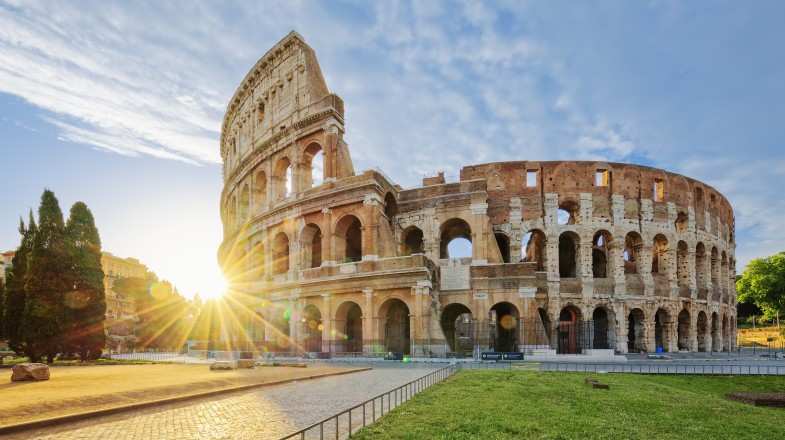The Colosseum: A Must Visit
The Colosseum is arguably one of the most popular monuments on your trip to Rome, Italy. This ancient and awe-inspiring piece of architecture leaves visitors speechless while transporting them back to a time of Roman gladiators and crowds of cheering spectators. To get a taste of what it must have been like to join the crowd and watch gladiators fight to the death inside the amphitheatre, or simply to enjoy the atmosphere surrounding a famous monument, a visit to the Colosseum is an absolute must.
- Carl
Quick facts
| Location: |
Piazza del Colosseo, Rome |
| Best time to visit: | When it first opens at 8:30 am, the low season months of November to February (save for Christmas Day and New Year’s Day) or an hour before the Colosseum closes (as by this time the crowds have significantly thinned out). |
| Opening hours: | 8:30 to 19:15 (April to August) and until 16:30 (during winter) |
|
Visit duration: |
3 hours (3.5 hours with the restricted underground areas) |
History of the Colosseum
The building of the Colosseum, also called the Flavian Amphitheater, started in 72 AD under Emperor Vespasian. It was inaugurated 8 years later by Vespasian’s son, Titus, although the construction work was finished two years later.
The Roman Colosseum could hold 50,000 – 80,000 people during the era of the Roman Empire. Along with gladiatorial contests, the Colosseum also hosted other events. Anything that entertained the Emperor, the elites and the common people was held here including classical drama, sporting events, executions, hunts, and wild animal fights.
The Colosseum served as Rome’s entertainment center for around 450 years. The fall of the Roman Empire, as well as changing public tastes, brought an end to the gladiatorial fights and other public shows by the 6th century. By then, the Colosseum itself had been damaged due to natural phenomena like earthquakes and lightning.
In the centuries that followed, the arena was completely abandoned, and its materials were used to build many projects, such as the Basilica of St. John Lateran, St. Peter’s Cathedral, the defence fortifications along River Tiber and the Palazzo Venezia.
But starting in the early 18th century, popes began to consider conserving the monument as a holy Christian site. Although it should be noted that it is uncertain whether any early Christians had actually been killed in the Colosseum.
By the 1900s, a combination of neglect, vandalism, weather and natural disasters had damaged almost two-thirds of the original building, including all of its marble seats and decor. Restoration efforts started in the same period and have continued since.
How to get to the Colosseum
You can easily access the Colosseum by public transport. Just next to the arena is Colosseo, the metro station of the B line.
To the south of the Colosseum is the tram station known as Piazza del Colosseo. Here, you can take the tram lines number 3 and 8 to reach Colosseum.
You can also get to the Colosseum by any of these bus lines: 118, 117, 87, 85, 75, and 51. You just have to alight at Colosso or Celio Vibenna.
From the airport, it takes an average of 20 – 30 minutes to reach the Colosseum by both bus and tram.
Colosseum tickets
A standard ticket, with access to the first and second tier of the Colosseum, the Roman Forum and the Palatine Hill costs USD 15 per adult, free entry for children under 17 years old and seniors over the age of 65.
There are a few ways to get tickets for the Colosseum, but here is what we recommend.
- Buy the ticket online through the official website to avoid long lines at the Colosseum ticket counter. Either bring the printed ticket or have the e-ticket ready at hand.
- Buy the ticket at the Palatine Hill ticket window. The ticket window is almost never crowded.
- You can also purchase your ticket through travel operators.
The ticket is valid for 48 hours. However, you can visit only one of the two attractions (the Roman Forum or the Palatine Hill) along with the Colosseum each day.
Alternatively, you can also buy a Roma Pass card. The pass is a tourist package which allows visitors discount privileges on local transports, events and exhibitions, entrance to museums and historic sites, including the Colosseum. Provided by the City Council of Rome, you can buy either 48 or 72-hour passes here.
Things to see at the Colosseum
While a standard ticket to the Colosseum gives visitors access to the first and the second tier of the structure, there is more to explore for those willing to make an extra effort.
- First and second tier: The first and the second tier is the floor on the Colosseum that was designated for the general public during the Roman empire. The masses could sit and watch the events from here. As a visitor today, you can check out the exterior as well as the interior architecture structure on this floor.
Besides this, there are three more areas of the Colosseum that have been opened for visitors in recent times. The arena floor, the belvedere and the hypogeum are the restricted areas in the Colosseum and can be accessed only through special tours.




- Arena floor: The stage for gladiator battles, the arena floor in the Colosseum has been witness to epic fights between beasts and men. Made of wood and covered in a layer of sand, the floor was destroyed in the 6th century after the end of the gladiator battles. Today a section of it has been reconstructed to give visitors a taste of its earlier grandeur. The upper seating areas underline just how vast the monument really is!
- Hypogeum: Underneath the arena floor is a network of tunnels, chambers and cells, where slaves, prisoners, gladiators and animals stayed during public events and spectacles. With most part of the arena floor gone, visitors can get a clear view of the hypogeum below.
- The belvedere: This area of the Colosseum includes the third, fourth, and fifth tiers. These upper rings of the structure have recently been opened to visitors after restoration work, allowing a different perspective of the landmark. Enjoy an unobstructed view of the entire city, the arena below, and experience the unbelievable height of the Colosseum.
A special tour to these restricted areas costs approximately an additional USD 11, an extra cost that we highly recommend for a unique experience of the Colosseum. Led by the official Colosseum guides, the tour can be booked via tour operators. Please note that the tour can only host up to 24 people for a visit of 20 minutes, and due to its high demand, availability can be scarce. Hence, plan the tour in advance and book accordingly.
Take a Colosseum Tour
While you can always buy tickets to the Colosseum and explore it on your own, we highly recommend taking a tour. Given the influx of visitors, accessing the Colosseum on your own can be time-consuming, starting right from getting the tickets to getting passed the security check. With a private tour guide, not only will you avoid queues at the ticket counter, but with a guide's knowledge of special access points, you can also bypass longer security lines. Once inside, a tour guide’s in-depth knowledge of the structure and bonus insider’s tips can be rewarding too.
Rules to follow when visiting the Colosseum
- As you enter the arena, be ready for airport-style security, regardless of whether you have the skip-the-line tickets or you are part of a guided tour. Security has been beefed up in recent times, leading to even longer queues, particularly at peak times like during holidays and festivals.
- You are allowed to carry small handbags and backpacks into the Colosseum. But heavy luggage is forbidden. Naturally, firecrackers, knives and weapons are forbidden too, as are glass bottles.
- You are allowed to bring plastic bottles, providing you empty them before entering. There’s a fountain inside the Colosseum where you can fill up your bottles with drinking water.
Insider tips
To ensure an unforgettable visit to the Colosseum, here are some great insider tips:
- You should visit the Colosseum during both day and night. Like many of the world’s wonders, this arena deserves to be experienced at sunrise and sunset.
- Buy a combination ticket at the Palatine Hill counter. Queues are shorter there as compared to the queue at the Colosseum entrance which will save you time.
- Book your tickets in advance. If you are planning on buying your ticket at the entrance, then prepare to stand in a queue twice — once for buying the entry ticket and the second time for the security check — the queue wraps around the building’s exterior and inside. At least with an online ticket, you are in line for the security check only.
- The least hectic time to get into the Colosseum is after 15:00.
- Entry to the Colosseum is free the first Sunday of every month.
- Since the Colosseum is usually crowded, pick-pocketers can take advantage. Keep your belongings safe and try not to flaunt money and valuables.
- If visiting Rome from March to December, make the most of exploring the Colosseum at night. The entrance fee is a bit higher than for regular visits, but it is worth it.
- Selfie sticks are banned inside the Colosseum, so they are better left at the hotel.
- Wear comfortable shoes for the tour, as there are plenty of stairs to climb inside the Colosseum. Bring a hat for mid-day trips.
All in all, the Colosseum is one must-see destination to make the most out of your Italy trip. Standing at over 57 meters tall, this 1st century edifice looks even more imposing physically than in photos. Once you arrive, you’ll have the chance to stroll in and out of its hallways as though you’re in Ancient Rome.
For a seasonal overview, read our travel article on the best time to visit Italy.
The Colosseum can be added as a part of your customized tour to Italy with the help of our local travel experts. For more information, check our travel article on how many days to spend in Italy.






